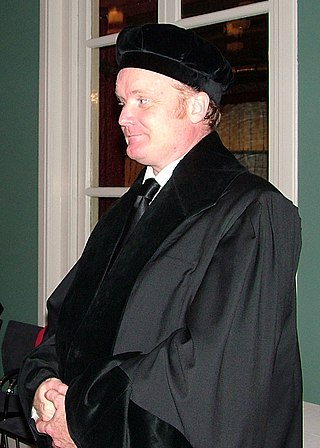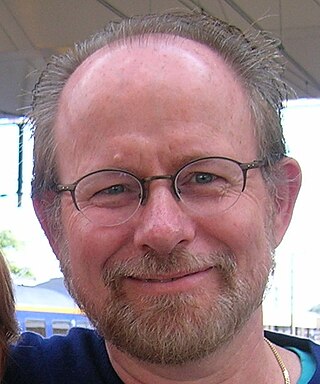Related Research Articles
In phonology and linguistics, a phoneme is a unit of sound that can distinguish one word from another in a particular language.
Phonology is the branch of linguistics that studies how languages or dialects systematically organize their sounds or, for sign languages, their constituent parts of signs. The term can also refer specifically to the sound or sign system of a particular language variety. At one time, the study of phonology related only to the study of the systems of phonemes in spoken languages, but may now relate to any linguistic analysis either:
Linguistics is the scientific study of language, involving analysis of language form, language meaning, and language in context.
Metathesis is the transposition of sounds or syllables in a word or of words in a sentence. Most commonly, it refers to the interchange of two or more contiguous segments or syllables, known as adjacent metathesis or local metathesis:
An iamb or iambus is a metrical foot used in various types of poetry. Originally the term referred to one of the feet of the quantitative meter of classical Greek prosody: a short syllable followed by a long syllable. This terminology was adopted in the description of accentual-syllabic verse in English, where it refers to a foot comprising an unstressed syllable followed by a stressed syllable. Thus a Latin word like íbī, because of its short-long rhythm, is considered by Latin scholars to be an iamb, but because it has a stress on the first syllable, in modern linguistics it is considered to be a trochee.
Isochrony is the postulated rhythmic division of time into equal portions by a language. Rhythm is an aspect of prosody, others being intonation, stress, and tempo of speech.
Flapping or tapping, also known as alveolar flapping, intervocalic flapping, or t-voicing, is a phonological process found in many varieties of English, especially North American, Cardiff, Ulster, Australian and New Zealand English, whereby the voiceless alveolar stop consonant phoneme is pronounced as a voiced alveolar flap, a sound produced by briefly tapping the alveolar ridge with the tongue, when placed between vowels. In London English, the flapped is perceived as a casual pronunciation intermediate between the "posh" affricate and the "rough" glottal stop. In some varieties,, the voiced counterpart of, may also be frequently pronounced as a flap in such positions, making pairs of words like latter and ladder sound similar or identical. In similar positions, the combination may be pronounced as a nasalized flap, making winter sound similar or identical to winner.

Jerzy Jan Rubach is a Polish linguist who specializes in phonology. He is a professor of linguistics at the University of Iowa and the University of Warsaw (Poland).
Jeroen van de Weijer is a Dutch linguist who teaches phonology, morphology, phonetics, psycholinguistics, historical linguistics and other courses at Shenzhen University, where he is Distinguished Professor of English linguistics at the School of Foreign Languages. Before, he was Full Professor of English Linguistics at Shanghai International Studies University, in the School of English Studies.
Sign languages such as American Sign Language (ASL) are characterized by phonological processes analogous to, yet dissimilar from, those of oral languages. Although there is a qualitative difference from oral languages in that sign-language phonemes are not based on sound, and are spatial in addition to being temporal, they fulfill the same role as phonemes in oral languages.

Marc van Oostendorp is a Dutch linguist and Esperantist. From 2004 he has served as a weekly commentator on linguistics for Radio Noord-Holland. Since 2007, he has researched phonological microvariation, dialectology and interlinguistics. He is currently attached to the Radboud University in Nijmegen.
Donca Steriade is a professor of Linguistics at MIT, specializing in phonological theory.

Wendy Sandler is an American-Israeli linguist who is known for her research on the phonology of Sign Languages.
Ellen M. Kaisse is an American linguist. She is Professor Emerita of Linguistics at the University of Washington (USA), where she has been affiliated since 1976.

Harry van der Hulst is Full Professor of linguistics and Director of Undergraduate Studies at the Department of Linguistics of the University of Connecticut. He has been editor-in-chief of the international SSCI peer-reviewed linguistics journal The Linguistic Review since 1990 and he is co-editor of the series ‘Studies in generative grammar’. He is a Life Fellow of the Netherlands Institute for Advanced Study, and a board member of the European linguistics organization GLOW.
Monik Charette is a French-Canadian linguist and phonologist who taught at SOAS the University of London, in the United Kingdom. She specializes in phonology, morphophonology, stress systems, vowel harmony, syllabic structure and word-structure, focusing on Altaic languages, Turkish, and French.
Colin J. Ewen is Emeritus Professor of English Linguistics and Phonology at Leiden University. He is known for his works on phonology and is an editor of the journal Phonology.

Richard Wiese is a German linguist, with academic degrees from the universities of Bielefeld and Düsseldorf. Since 1996, he is a professor of German Linguistics at Philipps-Universität Marburg, Germany, now retired. He has also worked at the universities of Bielefeld, Kassel, TU Berlin, and Düsseldorf.

Diane Brentari is an American linguist who specializes in sign languages and American Sign Language in particular.
Henk van Riemsdijk is a Dutch linguist and professor emeritus at Tilburg University.
References
- ↑ Syllables: Wilbur, R. B. (1982). A multi-tiered theory of syllable structure for American Sign Language. Paper presented at the Annual meeting, Linguistic Society of America, San Diego, CA.; Wilbur, R. B. (2011). Sign syllables. In van Oostendorp, Marc, Colin J. Ewen, Elizabeth Hume and Keren Rice (eds). The Blackwell Companion to Phonology, 1309–1334. Blackwell Publishing. Blackwell Reference Online. Blinks: Wilbur, R. B. 1994. Eyeblinks and ASL phrase structure. Sign Language Studies 84: 221 240.
- ↑ "Ronnie Wilbur - Speech, Language, & Hearing Sciences - Purdue University".
- ↑ Wilbur, R. B. (ed.) 2006. Investigating Understudied Sign Languages: Croatian SL and Austrian SL, with comparison to American SL. Sign Language & Linguistics 9, special issue.